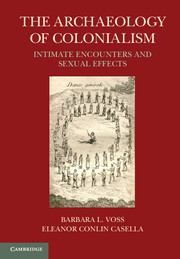Book contents
- Frontmatter
- Contents
- List of Illustrations
- List of Tables
- List of Contributors
- One Intimate Encounters
- Two Sexual Effects
- Section I Pleasures and Prohibitions
- Three Little Bastard Felons
- Four The Currency of Intimacy
- Five “A Concubine is Still a Slave”
- Six The Politics of Reproduction, Rituals, and Sex in Punic Eivissa
- Section II Engaged Bodies
- Section III Commemorations
- Section IV Showing and Telling
- Conclusion
- Index
- References
Three - Little Bastard Felons
Childhood, Affect, and Labour in the Penal Colonies of Nineteenth-Century Australia
from Section I - Pleasures and Prohibitions
Published online by Cambridge University Press: 05 June 2012
- Frontmatter
- Contents
- List of Illustrations
- List of Tables
- List of Contributors
- One Intimate Encounters
- Two Sexual Effects
- Section I Pleasures and Prohibitions
- Three Little Bastard Felons
- Four The Currency of Intimacy
- Five “A Concubine is Still a Slave”
- Six The Politics of Reproduction, Rituals, and Sex in Punic Eivissa
- Section II Engaged Bodies
- Section III Commemorations
- Section IV Showing and Telling
- Conclusion
- Index
- References
Summary
Affectionate Yearnings
In a letter dated February 25, 1848, prison inmate Ellen Cornwall wrote to her husband in Birmingham to explain the fate of their son Henry. At age four, the child had accompanied his convict mother to the British penal colony of Van Diemen's Land (Tasmania), Australia: “the Country did not agree with [our] dear boy. Although he had Medical attendance and everything was done that could be done. But it pleased the lord on the 7th of March to take him to his Heavenly abode out of this vain & wicked world. But my Dear Fredk I shall pass over this scene of sorrow. I only add that it was the greatest trial I ever had. I followed his remains and saw him laid in the Churchyard in the Town” (Casella et al. 2001: 106–107).
How do emotional bonds shape the material worlds of empire? For those entangled within colonial worlds, complex dynamics of personal surveillance, classification, compliance, negotiation, and reformation saturated everyday life. Further, as social categories became increasingly defined and delineated, the ‘individual’ emerged as a new imperial subject – whether indigenous, settler, creole, visitor, or some complex blend thereof (Gosden 2004; C. Hall 2002; M. Hall 2000; Stoler 2002). As a disciplinary mechanism, this creation of the modern individual (or individualisation) was exacerbated within the stark context of the nineteenth-century Australian penal colonies – outposts of empire explicitly founded to achieve the combined goals of punishment, reformation, and deterrence on the criminal subject (Figure 3.1).
- Type
- Chapter
- Information
- The Archaeology of ColonialismIntimate Encounters and Sexual Effects, pp. 31 - 48Publisher: Cambridge University PressPrint publication year: 2011
References
- 3
- Cited by



